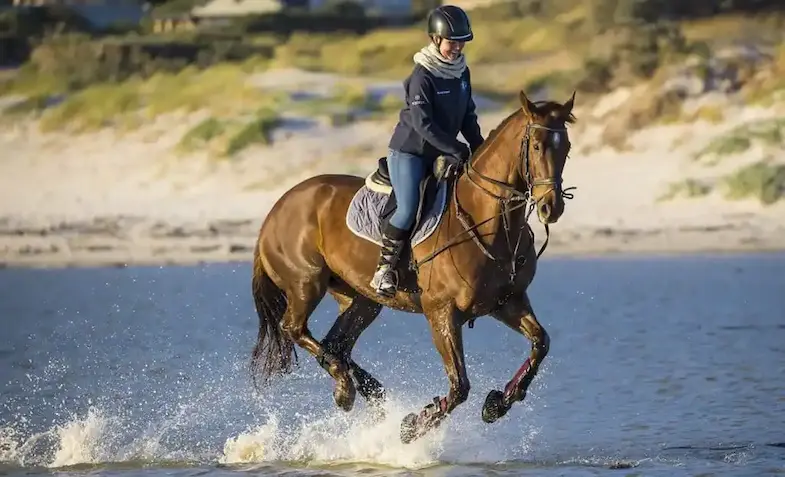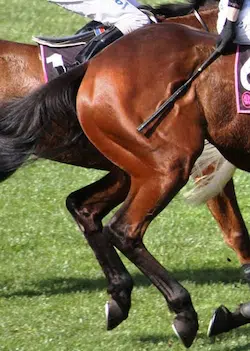No matter what the weather and no matter how we feel we all love riding, nothing beats the freedom we feel while out on our horses, whether it’s a fun beach ride or a high-speed barrel race there’s nothing like it. But, be honest, how many of us have stopped to think about if our beloved horses enjoy being ridden as much as we enjoy riding them?
The good news is that yes horses do like being ridden, although it’s not so much the act of being ridden it’s more that they know that it makes us happy and that we keep them safe and take care of all of their food needs. After all, how many wild, untrained horses have walked up to a stranger and showed signs of wanting to be ridden? That said we all know that if a horse didn’t want to do something nobody on earth could make him do it!!
Do horses suffer from being ridden?
If you’re sensible and consider the horse then there’s absolutely no reason at all why a horse should suffer from being ridden. The important things to consider are:
Saddle – Does the saddle fit your horse properly? It’s important that you’re not only using the right saddle for your horse but that it’s also fitted properly too. A poor-fitting saddle can cause a lot of pain to the horse. Check out this article on how to fit a saddle.
The right bit – Do you have the right type of bit for your horse? It’s important to use the right type and size of bit for your horse. A too harsher bit can not only hurt the horse but can also cause him to pull against it which will make it harder to control him. If you’re not sure what the right bit for your horse is you might want to read this article that I wrote recently.
Riding position – Make sure you’re sitting properly in the saddle and aren’t bouncing about too much. Not sitting correctly can put too much pressure on the wrong parts of your horse’s back.
Be gentle – Be gentle with your commands and don’t yank the reins. Remember that the reins are, indirectly, attached to your horse’s mouth.
Don’t push the horse too much – Don’t push your horse beyond his limits straightaway. If you’re preparing for an endurance ride understand that neither you nor your horse will be able to cover the full distance immediately, it’ll take time for the two of you to build condition and stamina.
Size of the rider – You might think that if you can ride you can ride any horse but it’s important to make sure you’re not too big for the horse as this can cause a lot of pain and discomfort for the horse. If you’re not sure what size horse you should be riding you may find this article helpful.
Why do horses let us ride them?
In order to understand why horses let us ride them, you need to understand how a horse’s mind works. Horses, like most other predated animals, have three needs from life, to eat, reproduce and be safe. Those three things are their priority and will take precedence over everything else and because we take care of their food and safety they’re happy for us to ride them.
The trust between a horse and rider is important and there’s no doubt that horses also see their owners as a member of the herd, albeit a rather funny looking and funny behaving member. Therefore they trust that what we’re asking them to do won’t hurt or harm them at all and as a result of this are often willing to do what we ask without questioning it.
What age should a horse not be ridden?
In much the same way you wouldn’t send a toddler out to work or expect a centenarian to run a triathlon you shouldn’t ride a horse that is too young or too old but what is classed as too young or old?
Regardless of the horse’s age, he shouldn’t be ridden until he has fully developed his legs and his knees have closed (until a horse’s knees have finished closing they’re still developing and are at serious risk of damage if ridden). Riding a horse whose knees haven’t closed properly can also result in permanent unsoundness.
So when do a horse’s knees finish closing? Just like people, horses develop at different rates, this is not only true for different breeds but for different horses from the same breed so it’s impossible to give a set age for this. For example, Thoroughbreds tend to mature earlier than other breeds while draft horses and some warmbloods won’t mature until they’re around 4 years old.
And what about when you should stop riding a horse? This is far harder to answer because there are so many factors that need to be taken into account, what’s the condition of the horse, is he sound, how has he been ridden during his life. If the horse doesn’t seem happy or looks like it’s in pain then he’s probably getting too old to be ridden.
Does using a whip hurt the horse?
While some people will argue that ‘a horse’s hindquarters are full of muscle and that the horse can’t feel much so a whip can’t hurt them‘ they may well be wrong. Yes, a horse’s hindquarters are extremely muscular but that doesn’t mean to say that a whip won’t hurt them. By its nature, they can inflame the area as well as cause bruising.
A horse’s skin is resilient which is where the myth that they can’t feel a whip comes from but that doesn’t mean the whip won’t hurt them or that it won’t cause them physical damage. In years gone by lashings or whippings were issued as a form of punishment so it stands to reason that, although a horse’s skin is much tougher than ours it’ll still hurt them.
It’s also worth noting that while no studies have been carried out as to whether or not whips do hurt horses there has also been no evidence to prove they don’t hurt. Even in horse racing, where the whip has routinely been used, recent rule changes have said that the jockey must use the whip no more than five times during the last 100m.
Is horse riding vegan?
This might seem like a strange question but the whole ideology of veganism is a way of living that seeks to exclude all forms of cruelty and exploitation of animals whether it be for food, clothing, etc so, for this reason, the question fits nicely into this article.
As long as you look after and respect the horse then horse riding isn’t cruel and doesn’t inflict any suffering at all so riding itself is definitely vegan. These days there is a wide choice of leather-free tack too so even this is vegan.
Conclusion
To sum everything up horses can enjoy being ridden if you ride them with care and consideration. Horses are highly intelligent animals so they can find riding fun, especially if they’re learning something new and aren’t just going through the same set of actions every time.
To the horse though it’s more important that you’re happy and that they’re safe.
Further reading
- Learn to ride in 12 easy steps
- How to be a better rider
- Getting back into riding again
- How Western & English differ
- Top Western disciplines
- Popular English disciplines
- Guide to the best gloves
- Equestrian vaulting
I hope you found this article helpful. If you did I’d be grateful if you could share it please as it would really help me.
Recommended products
Over the years I have tried hundreds of different horsey products, from various blankets and halters to different treats. Some I’ve loved, others I’ve hated but I thought I’d share with you my top all-time favorite products, the ones I never leave the yard without. I’ve included links to the products (which are in no particular order) that I really think are great.
- Horse Knots by Reference Ready – If you’re like me and enjoy pocket reference guides then you’ll love this knot tying guide. These handy cards can easily fit in your pocket or attach to the saddle for quick reference. They’re waterproof, durable and are color coded to make them easy to follow.
- Mane ’n Tail Detangler – Even if you never show your horse you’ll need to detangle his tail from time to time (and possibly his mane too) which is always a challenging chore! I’ve found that if I run a little bit of detangler through my horse’s tails every few days it stops them from getting matted up and makes combing them easy, even if they’re coated in mud. I don’t know if I should admit to this or not but it also works wonders on my hair.
- TAKEKIT Pro clippers – Over the years I’ve tried a lot of different clippers and while some were obviously better than others I found these to be by far the best. They are heavier than a lot of other clippers but for me, that’s a good thing, it makes them feel more sturdy and hardwearing. On top of that they have a range of speeds so are just as good for clipping your horse’s back as they are his face. I also like the fact that they come in a handy carry case but that’s not for everybody. The company that makes them is super good and incredibly helpful too, a real bonus these days. The only thing I wasn’t keen on was the fact that it doesn’t come with any oil, but that’s not a major problem as it’s not difficult to buy lubricant.
- Shire’s ball feeder – There are so many boredom buster toys out there but I like to use these every day, regardless of whether or not my horses are bored. I find that it helps to encourage my horses to problem solve by rewarding them with treats (or pieces of fruit) but it also mimics their natural grazing behavior which helps to keep them calm and de-stressed.
- Horse safe mirror – This is a strange one that many people are surprised about but I like to put horse safe mirrors in the trailers as well as in the quarantine stalls. It helps to prevent the feeling of isolation by giving the impression of other horses being around. Being herd animals horses can get extremely stressed when they feel that they’re on their own but with these stick-on mirrors, they believe that at least one other horse is with them.
- Rectal thermometer – I know this isn’t glamourous at all but it’s vital for your horse’s well-being to be able to check their temperature and a rectal thermometer is the easiest way of doing this which is why I’ve added it to the list.
Shopping lists
I’ve also put together a few shopping lists of essential items that I’ve found helpful over the years. I’ve broken the lists down into different categories rather than put everything in one massive list 😉


